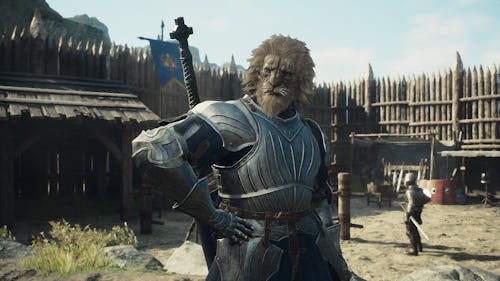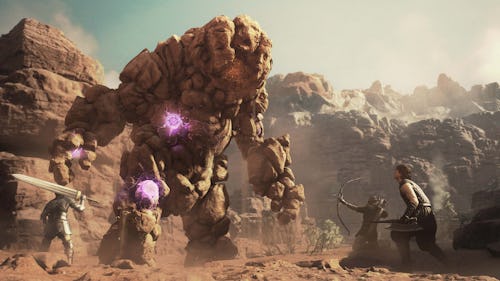
More than a decade after its predecessor, Dragon’s Dogma 2 was released in March to immediate commercial success. In just its first week, it sold 2.5 million copies, according to Capcom. The original Dragon’s Dogma sold under a million copies in that time, and since its launch, it’s sold just 7.5 million (including sales of the enhanced Dark Arisen version of the game and a Nintendo Switch port). Clearly that’s good for Capcom, and anyone who wants to see the series continue, but given the reaction to the game’s release, Dragon’s Dogma 2 may be a victim of its own success.
The launch of Dragon’s Dogma 2 was a flashpoint kicking off waves of equally passionate condemnations and defenses as the idiosyncratic game reached an audience largely unprepared for what they were getting into. Other than obvious flaws like bugs, nearly every aspect of the game’s design has been held up as both an abject failure and a brave, challenging choice on the part of the developers by people on either side of the debate.

Aside from a few incidents of players harassing streamers and critics for not divulging the game’s trivial microtransactions, this divided reaction is mostly healthy. Everyone’s taste differs, so one player’s genius gameplay mechanic is another’s glaring design flaw. But on some level, the more vitriolic responses to Dragon’s Dogma 2 might be fueled because a game meant to satisfy a specific type of player was sold as “the next big RPG” on the level of Skyrim or The Witcher 3. With trailers focused on combat or narrated by actor Ian McShane, there was little reason to suspect that Dragon’s Dogma 2 wouldn’t fit neatly into expectations for the genre.
I need to be clear: I’m a Dragon’s Dogma sicko. I bought the first game shortly after its release based on just how strange it sounded in reviews. I played Dark Arisen when it launched, and the Switch port. I’m firmly of the opinion that controversial features like Dragonsplague are good, and that the game fundamentally wouldn’t work if it didn’t make travel such a pain. So even when I encounter frustrations like Pawns’ often baffling AI or a bug that made an entire village hostile to my character for no clear reason, I can shrug those off as flaws in an otherwise stellar experience. Just like how I don’t mind that my cats in real life have utterly destroyed my apartment because I love them, but if a stranger came in and tore down my curtains I’d be far less forgiving.

And to a lot of players, Dragon’s Dogma 2 is a stranger. If you haven’t played the first Dragon’s Dogma, you’d have no way of knowing what to expect from the sequel, because there’s just nothing else like it out there. Previews of the game gave some hints of its quirks, but even attentive readers wouldn’t have gotten the full picture of just how different Dragon’s Dogma 2 feels from other RPGs, and a few hours with a game before release can’t really convey the cumulative effect of dealing with its sometimes antagonistic design for dozens more.
The gulf between reality and expectation was even greater for anyone who relied mostly on publisher Capcom for information. Game marketing is always going to sell players on the flashiest parts of a game, while leaving out its mundane or frustrating aspects. The problem when it comes to Dragon’s Dogma 2 is that things like the slow pace of travel, the obtuse quest descriptions, and the ability to be totally screwed over by the passage of time — the kind of things that weren’t conveyed in its marketing — are exactly what fans love about the game. Players unfamiliar with the original were sold on exhilarating battles against griffins and a compelling system of AI companions, when so much of the actual game is about deciphering vague NPC dialogue and deciding how many apples you should take on your next journey. It feels a little bit like expecting a new Super Mario game and receiving the punishing physics-based puzzle of Getting Over It with Bennett Foddy. Sure, they’re both platformers, but they have very different goals.

Part of what made Dragon’s Dogma fans into such evangelists for the game was its slower, more subtle success. It sold in the millions and garnered glowing reviews on release, so it’s not exactly a cult classic, but it has the feel of one. Despite its positive reception, Dragon’s Dogma never became a phenomenon the way its sequel has, and its release wasn’t preceded with such ceremony. Dragon’s Dogma’s fanbase grew mostly by word of mouth, and discovering it felt like gaining access to some secret club. It was always a game for weirdos willing to overlook plenty of issues to experience the kind of adventure that few games can offer. The same is true of Dragon’s Dogma 2, but instead of an idiosyncratic experience built for a specific kind of player, it was made out to be a game for everyone.
The fact of the matter is that there’s no such thing as a game for everyone. For some people, a highly polished game with broad appeal is as off-putting as Dragon’s Dogma 2’s rough edges are to others. But due to skyrocketing development costs, corporate demands for infinite growth, and probably many less visible reasons, a modest hit with niche appeal is simply unacceptable for a lot of publishers. I love Dragon’s Dogma 2 because it throws so many norms of modern RPGs out the window, but the reason those things became norms is because they work for most people. In reality, Dragon’s Dogma 2 is a game meant for everyone else, and it’s no wonder its millions of sold copies put a target on its back.
Dragon’s Dogma 2 is available on PlayStation 5, Xbox Series X/S, and PC.
FTTT
0 Comments